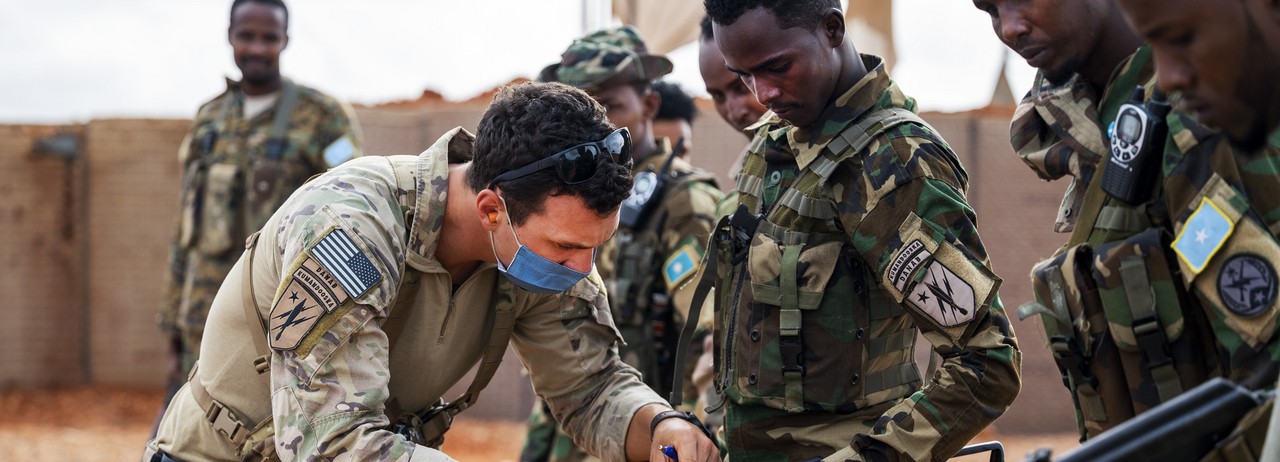U.S. forces host a range day with the Danab Brigade in Somalia, May 9, 2021. (Photo: US Air Force)
Meanwhile, Back in Washington, and Somalia, and Syria, and Kenya, and …
So we hear that former President George W. Bush finally came around to denouncing “the decision of one man to launch a wholly unjustified and brutal invasion of Iraq.” This unexpected and belated outburst of truth-telling and self-criticism was, of course, unintentional—just one of those verbal gaffes that the man once entertained the nation with on a regular basis. Realizing his error, the former commander-in-chief quickly explained that the unjustified and brutal invasion he was condemning was, naturally, not that of Iraq, but Ukraine. He brushed his faux pas off as a result of his advanced age, and the audience had a good laugh about it all.
Unfortunately, that crowd at the George W. Bush Presidential Library in Dallas was not the only group with reason to smile at the current state of affairs, for these are happy days throughout the entire war-making community. With the nation understandably and justifiably outraged at the Russian invasion of Ukraine, it’s been widely noted that NATO is back in favor, arms manufacturers are back in clover, and increased military spending is way back in vogue in Washington—not that it ever suffered much of a downswing, mind you.
What’s also happening these days is that the public are paying much closer attention than usual to matters of war. With the Ukraine invasion streaming on every screen, most Americans appear to know far more of the activities of the Russian and Ukrainian militaries than they know about their own—a situation that our domestic military policy makers are probably quite comfortable with. Unfortunately, the rest of us ought to be quite uncomfortable with this situation—as a glance at the back pages of the past week’s news will show.
First, there was the announcement that President Biden would be sending troops back to Somalia. Why? In the words of National Security Council spokeswoman, Adrienne Watson, the purpose is to wage “a more effective fight against Al Shabab.” Al Shabab, (“the youth”), a fundamentalist Islamic group thought to have 5,000-10,000 members, has been fighting for control of Somalia since the 2000s. The U.S. started bombing Somalia in 2011. The following year Al Shabab declared allegiance to al-Qaeda. The U.S. has bombed Somalia in every subsequent year. The reason we can be waging war in Somalia? Well, it’s not something much discussed, since the fact that we bomb Somalia is not much discussed in the first place. Used to be that the justification and authorization cited for almost all of the bombs we have dropped in this century was the 2002 Authorization of the Use of Military Force resolution (the one that only Democratic Rep. Barbara Lee of California opposed.) Since that authorization was actually repealed last September, the White House/Pentagon’s operative rationale here now seems to be a sort-of “We’ve always done it this way” thing.
This move on the part of Biden—who declared it “time to end the forever war” when he announced the withdrawal of all American troops from Afghanistan—will reverse President Trump’s decision to remove almost all of the 700 Americans previously stationed in Somalia, which Watson called “a precipitous decision to withdraw.” The unofficial word is that about 450 will return. Biden has also approved the Pentagon’s request to attempt assassinations of about a dozen suspected Al Shabab leaders, part of an overall effort—in the words of an unnamed senior administration official—to reduce “the threat to a level that is tolerable.” A prime example of the type of “threat” that Americans might face in that part of the world was the attack that killed three soldiers at the American air base at Manda Bay, Kenya on January 2, 2020. (American soldiers killed in Kenya? We’ll return to that.)
And elsewhere on the assassination-attempts-on-
The justification offered for this bombing was the defense of our Syrian Defense Force allies in Syria’s civil war. At the press conference announcing its report, Pentagon spokesman John F. Kirby characterized the Times’ findings as “not comfortable, not easy and not simple to address,” but he assured those present that “We actually do feel bad about this.” No wrong doing was found on the part of any American involved in the military operation, however, nor was anyone found to have improperly covered it up. And why are U.S. military forces currently at war in Syria? Again, it would pretty much seem to come back to the undeniable fact that this is just the sort of thing we do, ever since four airplanes crashed into the World Trade Center and the Pentagon on September 11, 2001.
The very next day following the Pentagon’s self-exoneration in the Syria bombing, it took the opportunity to present even happier news: Defense Secretary Lloyd J. Austin III has nominated Lt. Gen Michael E. Langley to a position that puts him in line to become the U.S. Marine Corp’s first black four star general. If formally nominated by President Biden and confirmed by the Senate, Langley will assume the top position of the U.S. Africa Command, a group said to currently number about 2,000 men and women, about 1,500 of whom actually operate out of Stuttgart, Germany (a country that is host to 40 U.S. military bases and about 35,000 American military personnel). The actual extent of the Africa Command remains a bit murky, though. In 2020, the news website Intercept published a Pentagon planning document that listed 29 U.S. military bases in fifteen different African nations.
And why are we in Africa? According to the Africa Command’s website, the organization “counters transnational threats and malign actors.” Indeed, these “malign actors” do appear to be on the rise. For instance, in the course of the decade plus in which the U.S. has been bombing Somalia, the number of militant Islamist organizations operating in the continent has risen from about five to 25. And now it appears that there are at least 29 locations there where Americans might now be threatened.
So, with just a brief look at what’s not streaming on every screen, it’s hard to avoid thinking that if there were half as many Americans who knew what our own military was up to around the globe—or if there were half as many Americans who could name even half the countries we repeatedly bomb—as there are Americans who know what the Russian military is doing, people might start talking about making some real changes there.
We’ve had enough. The 1% own and operate the corporate media. They are doing everything they can to defend the status quo, squash dissent and protect the wealthy and the powerful. The Common Dreams media model is different. We cover the news that matters to the 99%. Our mission? To inform. To inspire. To ignite change for the common good. How? Nonprofit. Independent. Reader-supported. Free to read. Free to republish. Free to share. With no advertising. No paywalls. No selling of your data. Thousands of small donations fund our newsroom and allow us to continue publishing. Can you chip in? We can’t do it without you. Thank you.




























